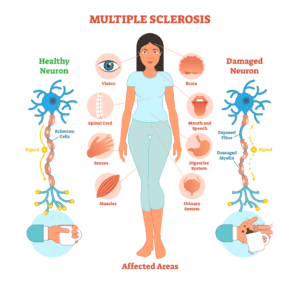Multiple Sclerosis: Introduction, symptoms, risk factors, causes, and diagnosis
Introduction
- Multiple sclerosis (MS) is the most common cause of neurologic disability.
- Epidemiological studies indicate that it is most common in the Northern Hemisphere and, interestingly, in the United States.
- Individuals with this disease produce autoreactive T cells that participate in the formation of inflammatory lesions along the myelin sheath of nerve fibers in the spinal cord and brain.
- Since myelin sheath functions in the insulation of nerve fibers, a breakdown in the myelin sheath causes numerous neurologic dysfunctions, ranging from numbness in the limbs to paralysis or loss of vision.
- Multiple sclerosis mainly affects the central nervous system (CNS).
- It leaves sclerosis or scar when the myelin sheath disappears or sustains damage in many places. Those areas are known as plaques or lesions.
It mainly affects:
- Brain stem
- Cerebellum
- Spinal cord
- Optic nerves
- Sometimes white matter
- Eventually, the nerves may become permanently damaged or weakened which results in the disease.
- Due to the development of lesions, nerve fibers may split or become weakened.
- The electrical impulses or signals from the brain do not travel easily to the target nerve as a consequence. This implies that these tasks cannot be carried out or performed by the body.

Multiple Sclerosis Symptoms
There are various signs and symptoms of sclerosis which can vary dramatically from one person to another, majorly depending on the location of damaged nerve fibers.
Sometimes, symptoms influence movement, such as:
- Numbness or weakness in joints usually occurs on one side of the body or your legs.
- Electric-shock sensations that occur on the action of certain movements of neck particularly forward bending of the neck (Lhermitte sign).
- Slurred speech.
- Tremor, insufficient coordination, or unstable gait.
- Fatigue.
- Dizziness.
- Pain or tingling occurs in certain body parts.
- Issues with sexual, bowel, and bladder function.
- Problems with vision are also popular, including: Total or partial vision loss, Double vision prolonged, Blurred vision.

People suffering from MS may also contract the following:
- Muscle stiffness and/or spasms.
- Paralysis.
- Mental changes for example mood swings and short-term memory loss.
- Depression.
- Epilepsy.

Multiple Sclerosis Risk factor and causes
- Even today, the causes of multiple sclerosis are still a mystery to scientists.
- It is an autoimmune disease, in which the immune system of the body attacks its own tissues and organs.
However, the risk factors have been starkly identified. These are:
- Age: in most cases, individuals between the age group of 20 & 40 undergo a diagnosis.
- Sex: Most types of multiple sclerosis are more likely than men to impact women twice as much.
- Genetic factors: Susceptibility can pass through genes, but scientists agree that it is often important for Multiple sclerosis to develop an environmental cause, even in people with unique genetic characteristics.
- Smoking: It is discovered that individuals who smoke are more likely susceptible to develop MS. They seem to have more tumors than a non-smoker.
- Infections: Infection by certain viruses, such as Epstein-Barr virus (EBV), may predispose a person to MS. Some viruses can cause demyelinating diseases, but the data linking viruses to MS are not definitive.
- Vitamin D deficiency: individuals with less exposure to bright sunlight are more commonly affected, bright sunlight is essential for vitamin D to be developed by the body.
- Vitamin B12 deficiency: When myelin is made, our body uses vitamin B. The risk of neurological disorders such as MS increases in the case of lack of this vitamin in our body.
There are numerous risk factors that come together and cause this disease.

Multiple Sclerosis Diagnosis
Diagnosis of MS involves the following tests:
- MRI scans for the detection of lesions in the brain/spinal cord.
- Evoked potential test.
- Spinal fluid analysis.
Reference and Sources
- https://www.disabled-world.com/health/neurology/disorders-list.php
- https://www.ncbi.nlm.nih.gov/pmc/articles/PMC4758194/
- https://pedirostoba.com/health/neurology/disorders-list–nk3952-jon.php
- http://www.jiwaji.edu/pdf/ecourse/zoology/Primary%20and%20secondaryImmuno-deficiency.pdf
- https://www.ncbi.nlm.nih.gov/pmc/articles/PMC8290177/
Also Read
- Toxins-Introduction, Types and Mechanisms
- Fungal Diseases of Hair, Skin, and Nails
- Riboflavin: Fermentation, Harvesting and Uses
- Chromosomes: Structure, Morphology, Composition and Organization
- Biosafety Cabinet: Introduction, Development and Safety guidance
- Hansen’s Disease: Symptoms, Causative Agent, Pathogenesis and Treatment

Where the treatment sir